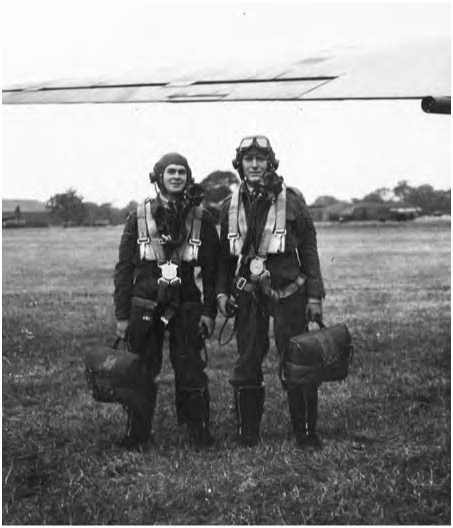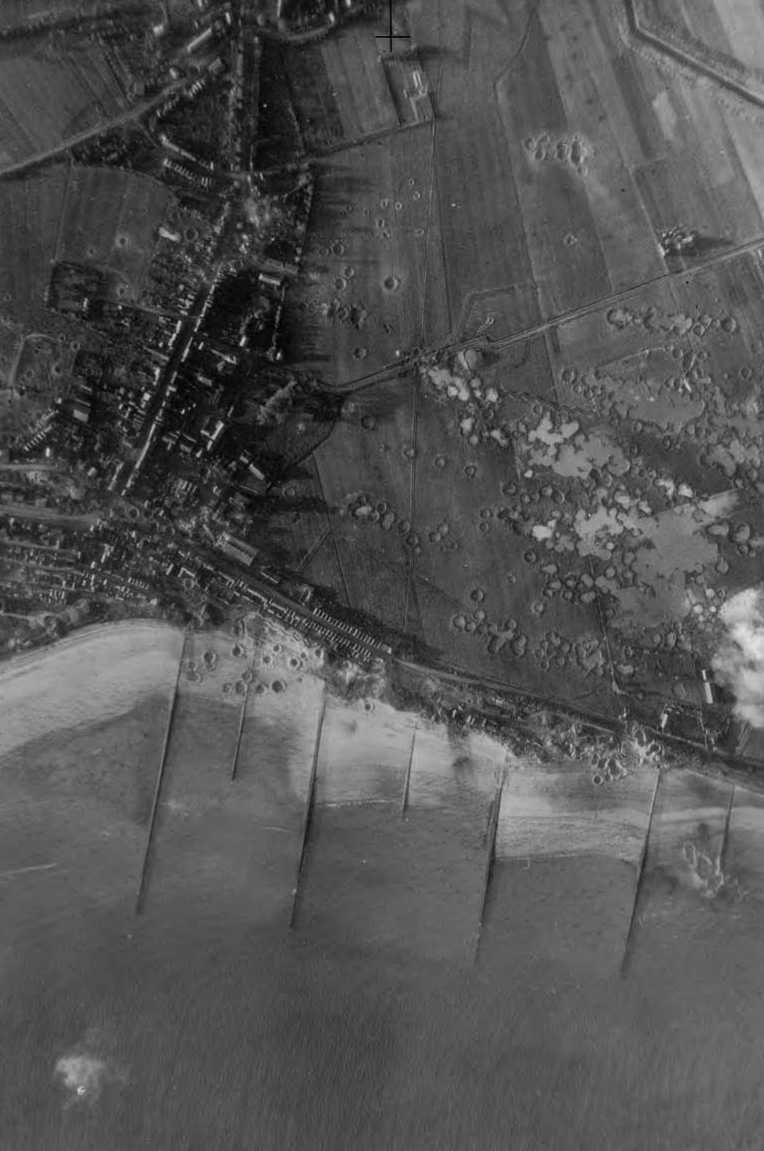Three more days of inactivity followed due to duff weather. But that did not stop David going out to J Jig each morning to check the plane and talk with its ground crew, the resourceful and dedicated erks - engine fitters, airframe riggers and others representing the many trades and skills necessary to keep aircraft operational. Each aircraft was allotted its own ground crew, who went into action as soon as the plane returned from any flying, no matter what time of night or day, checking, maintaining, repairing or rectifying any items listed by the crew in the snag book, and searching for other problems only their trained eyes could identify. Regardless of rain, wind and freezing cold, they worked tirelessly to keep ‘their kite’ in tiptop condition, ready to fly again when the next op was called.
Fitters worked on the engines, which as well as propelling the aircraft, powered all its equipment and accessories. Each of the four operated specific items, such
Sitting on bombs and trailer, L-R: Pop, Boz, Drew, Murga. The Squadron’s code letters were CF.
As gun turrets, bomb sight and doors, and the electrical generators for Gee and Y, to name but a few. Fitters or WAAFs were responsible for the refuelling, an awkward job which usually took three people half an hour. A typical fuel load was 1000 gallons. At a mile a gallon this would take the aircraft to Happy Valley and back, with a little in reserve. If the fuel load was greater, the pilot would know he had a longer haul ahead. Riggers looked for and repaired damage and faults in the fuselage.
Erks would also be there in their oil-stained clothing at the run-up to deal with any defects or malfunctions which might be revealed. They would be there before take-off, hoping the pilot would find nothing to enter on Form 700, which would mean their kite was u/s, resulting in a frenzy of activity to make it airworthy in time. They would chat to their pilot to ease the tension of waiting until it was time to start engines. They would listen to their Merlins throbbing into life, running sweet and true, settling into a steady rhythmic roar. Then when the green signal by Aldis lamp shone from the control caravan at the end of the runway, they exchanged the thumbs-up sign with the pilot. This was the signal they had all waited for, that would set their kite, their crew off. Now it was ‘Chocks away’. And they would feel the blast of air from the props and hear the squeal of brakes, as their pilot rolled their kite out of dispersal, taxying along the perimeter track.
They would watch her growing smaller, one in a line of Lancs moving slowly, pregnant with bombs, heavy with fuel, earthbound clumsiness belying her speed and grace in the air. They would suck in their breath as their kite finally reached the end of the runway in use. They

Gunners Boz and Birdy wearing harness and carrying parachute packs
Would hear their four Merlins bellow their power as their kite surged forward, gathering speed, lifting off into her rightful element. They would watch her underbelly, black against the grey day, or her nav lights, red and green against the black night, as she gained height, then disappeared from sight.
Heading where? Into what?
‘God speed,’ they would murmur, knowing they had done everything they could to ensure the safety of their boys.
Then they would load up their tool kits and head back to their quarters to snatch some food and a few hours of desperately needed sleep, before waking in time to return
To dispersal to welcome their kite, their boys back home. Or wait, wondering, watching, hoping, praying, for the ones who did not make it. Staring at the empty sky. Staring at the empty dispersal bay. Straining their ears for the sound of their Merlins, their kite. Swallowing hard. Forcing down their grief. Muttering, ‘Bloody Huns’. Turning away. Hollow with emptiness. Pierced with pain. ‘This bloody war. I could be home snug in bed with the wife now instead of freezing my butt off out here on this wasteland. Bloody war. Bloody Hitler. Blast him to hell.’
Armourers, too, played a critical role in the Lancaster team. Not only did they do the task of bombing up, loading the bombs, they were also responsible for seeing to the armaments, ensuring the guns were all in working order. DIs, as daily inspections were known, were meticulously carried out on all the guns and turrets as well as the bomb gear. Icing at high altitudes affected the guns and could crack the perspex turrets. Guns had to be cleaned after each op or training exercise, ammunition tanks filled and belt alignments corrected to avoid jamming or stoppages. It was life or death stuff for the aircrew and the armourers took their work very seriously. Birdy and Boz usually went out to check the mounting of their guns, which were taken off the aircraft after each sortie.
The first indication that an op was planned was always the call on the Tannoy, ‘Armourers report to bomb dump.’ Each team usually looked after five planes and had to collect the type and number of bombs specified for that particular raid. It was heavy, exacting work requiring brawn but also brains, manhandling the bombs onto special trolleys to be towed to dispersals. A portable winch put aboard the aircraft was used to lift the bombs
Into the 33-foot bomb bay in the plane’s belly, which extended almost half its length. They had to be stowed according to the order in which they would be used, 1000-pounders before 500s, cookies before incendiaries. It took upwards of 45 minutes to load a cookie and incendiaries. And there was no room for error. Each bomb was clamped for safety in flight and suspended by its own specially designed hook, with an electro-magnetic release for easy dropping over the target. A typical bomb load was 14 000 pounds. In loading over 30 tons of bombs armourers worked under pressure for at least four hours, so were always glad of help from the crew in bombing up if an op was called at short notice.





 World History
World History![Black Thursday [Illustrated Edition]](https://www.worldhistory.biz/uploads/posts/2015-05/1432470149_1431513568_003514b1_medium.jpeg)









